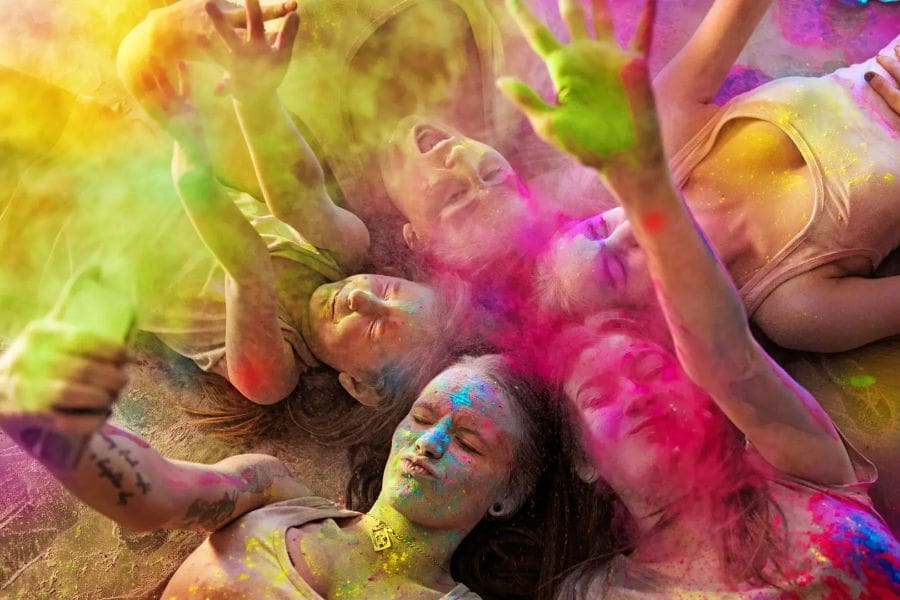What are chakras? In Sanskrit, the word “chakra” can be translated as “wheel” or “circle.” This refers to the spinning energy disks thought to be at the core of each energy center.
Do Chakras Exist?
The chakras do not exist in any real sense, they are not stuck there waiting for you to activate them. To ask “what are they?” has no real meaning. Rather ask, what you do with them? Chakras are the result of your practice; they are processes, not things.
Perhaps the best way to see Chakras is as a form of energy. Yet, energy does not exist as something we see and is only observable by its effect. Take a light bulb. The bulb only shines with light when the energy is activated. The bulb emits no light until switched on. Similarly, the Chakras and Kundalini energy need to be activated through daily practices. Turn off the practice, the energy in the chakras also turns off.
Spiritual awakening does produce observable changes in the doshas or bodies of the person. This is a multidimensional process. It is not only the energy body; the physical, emotional, mental, and spiritual body are also awake. Kundalini awakening amplifies energy and you also have better emotional amd mental balance, and improved physical health.
Chakra Systems
The chakra system we have come to know today came to the fore in the 15th century. The theory of subtle bodies and energy centers called chakras is from the tradition of Tantra Yoga. Tantra flourished between 600-1300 CE but is still alive today. In Tantra Yoga, different teachers used their own chakra systems. Some put used more than one. There are 5-chakra systems, 6-chakra systems, 7, 9, 10, 12 and 21. The chakra system you used depended on the taught text and lineage.
The seven (actually 6 + 1) chakra system best known in the West is only one of many systems. The older tantra texts work with a larger number of chakras. The lower, more physical, chakras are expanded with the meditative chakras. For instance, there may be two extra chakras next to the third eye in the forehead or many chakras above the crown of the head, which serve to move consciousness towards the infinite.

Chakras And Physical Glands
The linking of chakras to physical glands suggests an interplay between the energy centers and the endocrine system, which regulates vital functions like growth, metabolism, and sexual development.
Each chakra is said to align with specific glands within the endocrine system, as follows:
- Root Chakra (Muladhara): Reproductive glands.
- Sacral Chakra (Svadhishthana): Adrenal glands.
- Solar Plexus Chakra (Manipura): The pancreas.
- Heart Chakra (Anahata): Thymus gland.
- Throat Chakra (Vishuddha): Thyroid gland.
- Third Eye Chakra (Ajna): Pineal gland.
- Crown Chakra (Sahasrara): Pituitary gland.
This framework allows us to comprehend how the chakras influence the physical body, and how physical ailments may relate to chakra imbalances. For instance, disturbances in the Root Chakra might show up as issues with reproductive glands, while imbalances in the Third Eye Chakra could be linked to the pineal gland.
This correlation isn’t universally acknowledged and remains the subject of debate within spiritual and scientific circles. Many contend the chakra system transcends physicality. Nonetheless, exploring the connection between chakras and physical glands may offer profound insight into the interplay between the subtle and tangible aspects of our being.
Do Chakras Have Rainbow Colors?
The idea of crystal healing of chakras is a new-age Western invention. Certain crystals are believed to resonate with specific chakras. They may be used for meditation or for energy healing to enhance the flow of energy through the chakras. This idea finds no root in any of the original tantras. Benefits claimed are based on the subjective experience and anecdotal evidence of those practicing crystal healing techniques.
Chakras are often shown with rainbow colors. These colors are typically red, orange, yellow, green, blue, indigo, and violet. The order of colors of a rainbow. However, in the older texts the chakra system is more earth-colored than anything seen today.

Chakras And Psychological States
Countless websites and many books, we read that the Muladhara chakra is associated with survival instinct and safety, that the Maṇipura chakra is associated with willpower and self-esteem, and so on.
The link between the chakras with psychological states is a modern Western innovation that started with Carl Jung. However, there is a truth behind these notions. As Kundalini progresses through the chakras, you are likely to achieve a higher state of consciousness. Therefore we can see Jung’s idea as a motivation for people, with a concrete Western mindset, to know that through the chakra awakening process, they will reach a higher consciousness. They will increasingly let go of their fears and prejudices and instead experience more presence and wisdom in their lives. It’s a process and not something connected to individual chakras. Thus it is an invention that can work for Western people in need of concrete steps, images, and motivation.
In the original Eastern practice chakras are associated with the five elements, particular deities, and powerful vibrational sounds from the Sanskrit alphabet.
The Untapped Treasure Within
Each of the chakras is associated with specific spiritual, emotional, and physical attributes. Here is a breakdown of the spiritual elements associated with each of the seven main chakras:
1. Root Chakra (Muladhara)
Grounding: Represents our foundation and connection to the Earth. It’s linked to survival instincts and a sense of security.
Trust: Establishes trust in the physical world, promoting feelings of safety and stability.
Manifestation: Assists in bringing spiritual ideas into physical reality.
2. Sacral Chakra (Svadhisthana)
Creativity: Associated with creative energy, pleasure, and passion.
Emotional Balance: Governs our ability to experience and process emotions.
Desire: Connects with the flow of desire, intimacy, and sexual energy.
3. Solar Plexus Chakra (Manipura)
Personal Power: Relates to self-esteem, confidence, and the ability to assert oneself.
Willpower: Represents the energy of transformation, discipline, and personal growth.
Purpose: Connects with the realization of personal goals and purpose in life.
4. Heart Chakra (Anahata)
Love: The center of unconditional love, compassion, and empathy.
Connection: Facilitates emotional and spiritual connections with others and the universe.
Healing: Represents the energy of forgiveness, acceptance, and inner peace.
5. Throat Chakra (Vishuddha)
Communication: Governs truthful expression, communication, and the sharing of ideas.
Truth: Represents the pursuit and articulation of truth, both internally and externally.
Creativity: Supports the expression of creativity through speech, writing, and art.
6. Third Eye Chakra (Ajna)
Intuition: Enhances inner wisdom, intuition, and psychic abilities.
Insight: Facilitates the understanding of deeper truths and spiritual awareness.
Perception: Governs perception, imagination, and the ability to see beyond the physical.
7. Crown Chakra (Sahasrara)
Divine Connection: Connects to higher consciousness, divine wisdom, and spiritual enlightenment.
Unity: Represents the unity of the individual with the universe and the collective consciousness.
Transcendence: Facilitates the experience of transcendence, bliss, and the realization of one’s true nature.
Balancing the chakras leads to overall harmony and well-being. A balanced Root Chakra provides security and a strong foundation, while the Sacral Chakra promotes creativity, healthy relationships, and emotional stability. A well-tuned Solar Plexus Chakra enhances confidence, self-discipline, and a clear sense of purpose. The Heart Chakra, fosters love, compassion, and inner peace. A balanced Throat Chakra allows for clear, authentic communication. The Third Eye Chakra, sharpens intuition and spiritual awareness. Finally, the Crown Chakra connects you to higher consciousness, bringing a sense of unity and spiritual enlightenment.

